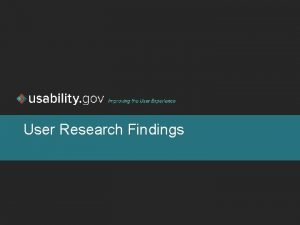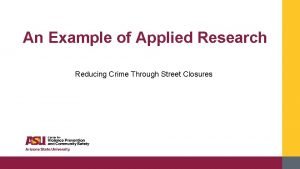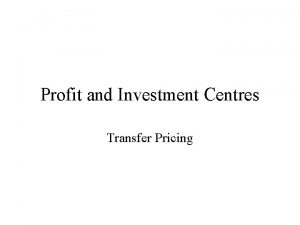Empirical research findings in international transfer pricing Christian









- Slides: 9

Empirical research findings in international transfer pricing Christian Plesner Rossing Copenhagen Business School & CORIT Advisory P/S

TP tax studies in management accounting and economics • Tax considerations are not the main driver of transfer pricing for intangibles (Borkowski, 2001) • Financial accounting regulation impacts APA enrollment (Borkowski, 2012) • Negative stock market reaction to regulation aimed at reducing tax avoidance through TP (Eden et al. , 2005; Eldenburg, 2003) • Is income-shifting through TP a ‘large-MNE’ phenomena? (Conover and Nichols, 2000; Langli and Saudagaran, 2004) • Cost-based TP method more likely when no local partners are part of management (Chan and Chow, 2001) • Subsidiary managerial autonomy is negatively correlated with outbound income shifting (Chan et al. , 2006) • Are tax strategies driving business strategies? (Glaister and Hughes, 2008) • Transfer pricing is used strategically to receive goodwill from local business institutions (Cools et al. , 2008)

Professional surveys of MNE practices Ernst & Young 2013 Global Transfer Pricing Survey Transfer pricing priorities 2012 2010 2007 Tax risk management 66% 50% ETR optimization 11% 18% Cash tax optimization 6% 7% Allignment with management/operational objectives 14% 20% 18% Performance measurement 1% 5% 7% None of these 1% 0% 3% 22% EY survey, Page 15

Ernst & Young 2013 Global Transfer Pricing Survey (continued) • 36% review their financial results only annually. • Italy is reported #1 country in which penalties were imposed (24%). India, Canada, and France follows (9%, 7%) • IG financial arrangements were considered a (slightly) more important area of transfer pricing controversy than TP of intangibles. • Only 21% reported taken customs issues fully into account in transfer pricing planning. • 41% report that their systems are not set up for tax and transfer pricing; 58% (!) rely on Microsoft Excel spreadsheets to perform TP analytics. • 7 % of parent companies report they have ‘highly automated’ systems supporting TP data needs for analysis, monitoring and planning.

Professional surveys of MNE practices Tax Executives Institute’s 2011 -2012 Corporate Tax Department Survey • • • External consultants makes up 22% of tax department budget Top-5 KPI of tax departments: 1: Lack of surprises; 2: Results of audits; 3: Compliance deadlines met; 4: Cash Taxes; 5: Effective tax rate 33% of responding companies’ Senior Tax Executive never meet with internal audit to discuss tax risk 77% of responding companies do not have a formal tax risk management policy 51% of transfer pricing consultants used by respondents represent a ‘Big-4’ (54% on APAs) 83% of respondents report no integration between ERP-system and tax compliance system (manual import of data)

Observations and current research • Is transfer pricing becoming a marketing tool? (Starbucks U. K. ) • What structural features trigger APA enrollment? (IRS APA Reports) • Are MNE effective tax rates lower than domestic firms? (ORBIS) • Output vs. process-based key performance indicators for TP in MNEs


Transfer pricing in the future • More emphasis on the role of integrating and automating ERP and IT applications in operational transfer pricing and tax compliance exercises • Higher APA activity due to increase in documentation requirements and value chain transparency (e. g. BEPS & Country-by-Country reporting) • Increase in demand for MNE in-house TP specialists • Increase in tax authorities’ assessment of ERP applications and their impact on TP outputs

Questions & comments
 Findings of qualitative research
Findings of qualitative research Findings example in research
Findings example in research Communication of research finding
Communication of research finding Kind of quantitative research
Kind of quantitative research Qualitative research results and discussion
Qualitative research results and discussion Qualitative vs quantitative variable
Qualitative vs quantitative variable Example of applied research
Example of applied research Translating research findings to clinical nursing practice
Translating research findings to clinical nursing practice Motivation module for students
Motivation module for students Reporting research findings
Reporting research findings

















